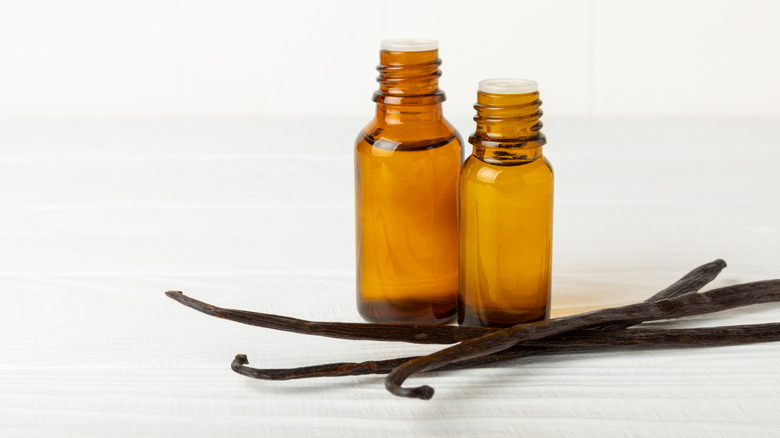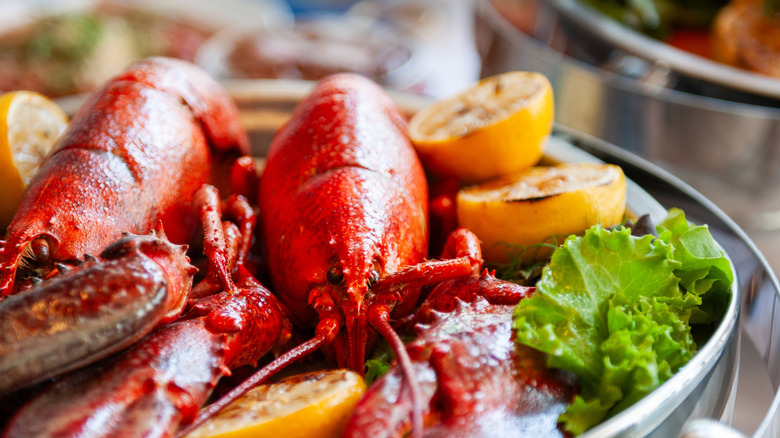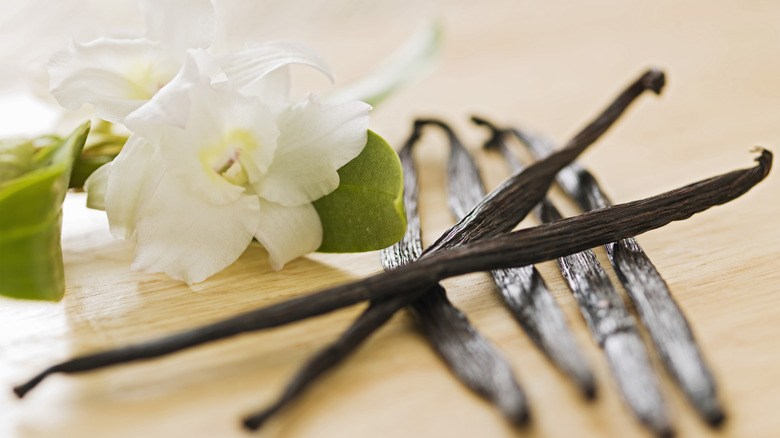Vanilla Might Just Be The Flavor To Pair With Your Favorite Seafood
As cooks, our minds often turn to sweets when we think of vanilla — ice cream, cake, or custards like crème brulée and panna cotta. Although it's complementary to sweetness, vanilla's predominant notes are spicy, buttery, and woodsy: Using it exclusively in dessert means never quite accessing its full potential. Indeed, vanilla has no end of savory applications, from making drool-worthy grilled meat to balancing the tang in a homemade vinaigrette. And though it might seem unlikely, it also pairs remarkably well with fish. It's an idea that is slowly entering mainstream cooking, with chefs like Heston Blumenthal popularizing the combination.
To find out more, we spoke to Michael Handal, chef at the Institute of Culinary Education's New York City campus. We asked him what kind of fish he would recommend pairing with vanilla — after all, any great dish starts with the right ingredients. "Mild, usually white-fleshed fish, such as sole, monkfish, striped bass, and red snapper, pair nicely with the flavor profiles of vanilla," he tells us. "These fish all have the benefit of being mild in flavor and suitable to complement the flavors that vanilla has to offer," explains Handal. You could also use more commonly found white fish such as cod, haddock or sea bream.
You could also try pairing your vanilla with other types of seafood, like shellfish
The marriage of seafood and vanilla isn't exactly a new idea. On Comoros, a small nation off the coast of Madagascar (which happens to be the world's largest producer of vanilla), the national dish is Langouste à la Vanille — lobster with vanilla sauce. It's a delightfully complex dish: The subtle sweetness of the vanilla brings out similar notes in the lobster while also contrasting with the natural salty undertone of seafood.
You could also take some inspiration from this Comoranian classic and experiment pairing vanilla and shellfish. According to Handal, "[L]obster, scallops, and shrimp also pair with vanilla in the same manner." Prawns would go particularly well here, since their sweeter, meatier taste works nicely with vanilla's subtly fruity, spicy notes. Vanilla also complements rich, buttery flavors, meaning that fish like salmon or trout also make for great options.
However, it's worth noting that there are some types of fish that won't work with vanilla. The flavor shines when providing a spicy top note for a relatively mild main event, but it can be overwhelmed by bolder, "fishier" flavors. "Oily-fleshed fish such as mackerel, tuna, and herring would be examples," Handal tells us. Vanilla is best suited to give a final lift and a touch of sophisticated complexity to dishes that carry a relatively delicate palate, so use it wisely.
What kind of dish works well when pairing fish with vanilla – and how do you actually do it?
When it comes to actually incorporating vanilla into your fish dishes, you have two main options: infusing its flavor during the cooking process, or adding after the fact by incorporating it into a sauce. As Handal explains: "In terms of how the seafood is prepared, dry-heat cooking methods, such as sautéing and grilling would be very nice. Moist-heat methods of preparation would include shallow poaching, deep-poaching, and steaming."
While those dry-heat cooking methods require a sauce that allows the vanilla flavor to come to the front of the palate, a cooking technique like poaching or even steaming the fish (en papillote, for example) presents an opportunity to inject real vanilla flavor into the fish itself. For example, when poaching, you could split a couple of vanilla pods and place them in the liquid alongside the fish, allowing their aroma to gently penetrate its flesh while it cooks.
Regardless, you should absolutely try making a vanilla sauce. "In all of these cases, the usual way to incorporate the vanilla would be via an accompanying sauce, such beurre blanc, vin blanc (white wine cream sauce), or any other lightly emulsified fish-based sauce that will allow the delicate essence of the vanilla to shine through," Handal says. The creaminess of an emulsified sauce would complement the vanilla and present a relatively neutral backdrop to allow its natural floral aromas to shine.
Other flavors, and what to do if you add too much vanilla
Vanilla's inherent sweetness makes it a natural pairing for savory dishes — and that means it pairs well with salt. For a particularly subtle touch of vanilla flavor that you can add to fish in the place of a sauce, try blending some kosher salt and vanilla beans to make a homemade infused seasoning salt. You could also combine vanilla with other spices, herbs, and floral flavors. "Herbs like thyme and lavender would be natural complements to both the seafood as well as the vanilla sauce," Handal notes. You could infuse them as part of a moist-heat cooking method like the ones we mentioned earlier; shallow poaching works well for this, and placing a sprig of lavender on top of your fish as it cooks can introduce a fine vanilla perfume that won't prove overwhelming.
Speaking of overwhelming, if you do end up adding too much vanilla to your sauce and want to save it, there's an easy way of paring back its flavor. "If you used too much vanilla bean in a sauce, you might be able to add an additional quantity of the base's liquid used in the sauce," Handal recommends. Additional fish stock, heavy cream, or even water can work to dilute the sauce's flavor, helping take it back to where it needs to be!




